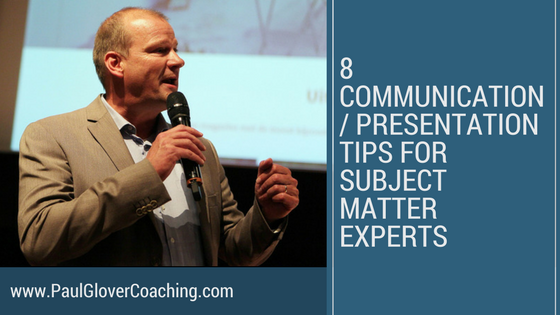
15 Apr 8 Communication / Presentation Tips for Subject Matter Experts
Most Subject Matter Experts (SMEs) like engineers, scientists, and financial experts, struggle when communicating/presenting to non-experts, whether it be one on one or in small or large groups.
To assist SMEs to become better presenters/communicators (and save the rest of us from presentation hell!), here are 8 Tips from a Communications Workshop I recently conducted for a group of engineers:
1. Know the purpose of the communication/presentation: Every SME needs to begin every communication/presentation process by deciding what the purpose of the communication/presentation is before a single word is spoken or written. Without the SME clearly knowing the purpose, the communication/presentation will inevitably wander off course and be unfocused, confusing and frustrating for all parties.
2. Profile the Audience: Most SMEs believe their non-expert audience understands the basic concepts of the SMEs area of expertise. This is seldom true, but the audience won’t admit this lack of knowledge for fear of looking stupid. The SME needs to accept the fact most of a non-expert audience, whether it’s a single person or a roomful of people, will not have a clue about the subject matter expert’s field of expertise. Only then can the SME build a relevant conversation/ presentation and introduce the basic concepts by relating the presentation/communication to something a majority of the audience can relate to (i.e. a financial SME can relate financial concepts to keeping a checkbook).
3. Accept responsibility for delivering the message: A SME seldom realizes it is their responsibility to craft a communication/presentation which will be understood by their non-expert audience. Instead of thinking it is the audience’s obligation to understand what is being presented, they need to accept the responsibility for presenting the content in a format and language that allows the non-expert audience to understand and be able to process the information being presented. BTW: Answering the needs of the audience is the reason for the conversation/ presentation, not to impress the audience with the intelligence of the SME. HINT: When the audience’s eyes glaze over or they develop the thousand yard stare, the SME needs to stop and ask the audience questions to determine where they lost them. Then they need to go back and simplify the message. Proceeding with the presentation/ communication if the audience is lost is a waste of time for everyone.
4. Avoid jargon: As a part of the responsibility to deliver an understandable communication/presentation, a SME needs to eliminate as much of the jargon they believe is possible – and then they need to eliminate the rest of it. Non-experts either don’t understand the technical terms, misunderstand them or don’t know what the abbreviations mean. HINT: the audience’s eyes spinning in their sockets, is a good indication they don’t understand the language being used.
5. Death by PowerPoint: The PowerPoint is not the presentation; the SME is. If that isn’t the case, the SME should email the PowerPoint to the audience and not waste their time by reading the PowerPoint to them. HINT: If the presentation requires extensive explanation, it should be provided in a handout sent to the audience before the communication/presentation. Most SMEs believe the more information crowded onto a PowerPoint slide the better. Not true. Less information on a slide is better. BTW: there is no limit to the number of PowerPoint slides that can be used in a presentation – however, see #7 below – so SMEs need to stop crowding them with so much stuff they are difficult to read.
6. Amount of material: Presenting any more than three major points in any communication/presentation is a waste of time, dilutes the attention of the audience and confuses them. Unless the SME is a Bernie Madoff wannabe, there is no reason to do this.
7. Amount of time: Ted Talks are 18 minutes long for a reason: the attention span of the average audience is 18 minutes. If a communication/presentation is going to be longer than 18 minutes the SME needs to “reset” the audience with a question and answer period or another activity before moving on to the next segment of the communication/presentation.
8. Tone and attitude matter: Being a SME is not a reason to act superior to the audience. SMEs who disdain their audience by looking at their watch (meaning: I have something much more important to do), rolling their eyes when asked a rudimentary question (meaning: how stupid can this person be?) or adopting a condescending manner towards the audience (meaning: because I know more about this topic than you do means I’m better than you) should not be communicating/presenting to non-experts. SMEs need to remember the audience is full of other SMEs, just not in the presenter’s area of expertise.
The Bottom Line: The Subject Matter Expert is in control of the communication/ presentation process. If the information presented to the audience is important, it’s the SMEs obligation to ensure the audience understands the information and benefits from the communication/ presentation. If the audience does not leave the communication/presentation with something of value, it is the SMEs fault — not the fault of the audience.


No Comments